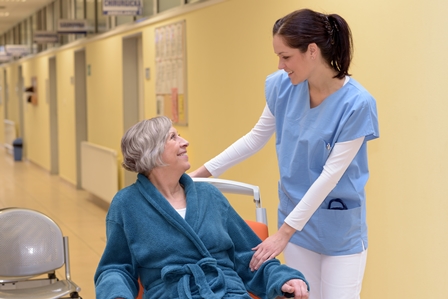By Anthony Remaud and Michaela Berniquez
A team at Ottawa’s Saint-Louis Residence is working at improving falls detection systems in long-term care (LTC) homes. They’ve come up with a solution to receive alerts as soon as a fall occurs, while collecting accurate information of what happened. They have turned to Artificial Intelligence to help turn this idea into a reality.
Importance of falls in the LTC sector
In Canada, half of all LTC residents experience one or more falls annually. In addition, if a resident has fallen in the past, they are at high risk of falling again. According to the Public Health Agency of Canada, 40 per cent of those who fall once will fall again at least twice more that same year.
Not only does falling have a serious physical and psychological impact on an individual’s quality of life, it also contributes to a significant burden on health systems. Many resources and services end up being directed to address the consequences of falls. In 2014, the Canadian Institute for Health Information estimated the annual direct health care costs for falls in Canada at $2 billion.
The variety of factors that can contribute to a fall can make prevention strategies difficult to implement especially as homes strive to support the independence of residents. A key challenge is that most falls in LTC homes are unwitnessed, and that falls most often happen when care providers are less available due to peak care demands or shift changes. Current fall detection systems in LTC homes often require that the resident call for assistance after a fall occurs, which they may not be able to do. In these cases, the resident may remain on the floor until found by a staff member. As no witness exists and the residents themselves are often unable to communicate exactly what occurred, it is challenging for front line staff to understand what happened and to put appropriate preventative measures in place.
Artificial Intelligence to help detecting and preventing falls
The RemoCare TeleHealth System is an advanced remote care solution developed by Remotronic Inc. that uses the built-in camera in today’s smartphones/tablets to capture important health data for viewing by point-of-care staff. RemoCare then uses artificial intelligence to continuously analyze the videos to identify a fall. When a fall is detected, an alert is sent to front line caregivers, who can then determine follow-up action.
RemoCare has demonstrated its ability to accurately detect falls and to provide an alert when one occurs in community settings. However, falls in a LTC facility can look very different than those experienced by people who live in the community and are usually more mobile. Falls in LTC homes can occur with less motion, at slower speeds, may involve mobility aids (e.g. walkers and wheel chairs), and may be more difficult to distinguish from a normal range of motion within the room.
A first pilot study in LTC settings
Since the beginning of this year, the Saint-Louis Residence team of managers and front line nursing staff and supported by the Bruyère Centre for Learning, Research and Innovation, has been working on the project aimed at assessing the effectiveness of the RemoCare TeleHealth System in detecting falls in a LTC setting. This activity is funded by the Centre for Aging + Brain Health Innovation (CAHBI) Spark Program. After gathering ethics approval, the team is now preparing to monitor and collect resident data. Feedback and comments were gathered from staff and families at meetings and through open houses.
For this first field testing, data collection will only involve a small group of volunteer residents. Smartphones with the RemoCare application will be placed in rooms of LTC residents that are known or suspected to be at high risk for falls. Should a fall be detected in a resident’s room, a real time alert showing a video of the time leading up to and following the event will be sent to point-of-care staff. Staff will be equipped with smartphones to receive the alarm and view the video of the event to determine follow-up actions, in addition to existing processes.
Promising perspectives for fall prevention in LTC homes
Falls Prevention and Management Program policies and procedures are based on validated and reliable results collected on large data samples. As a result, more data will be needed at the Saint-Louis Residence before any change to existing evidence-based policies and processes can be made. Still, this technology has the long term potential to reduce the frequency of falls in LTC by allowing front line staff to learn from and adapt to the causes of falls. If successful, the RemoCare TeleHealth System could be implemented in other LTC homes across not only Ontario, but Canada as a whole.
Disclaimer:
The project Intelligent Mobile and Web-Based Alerts Application: Detecting and preventing falls in the long-term care setting is supported by the Centre for Aging + Brain Health Innovation (https://www.ccabhi.com) and by the Bruyère Centre for Learning, Research and Innovation (CLRI) in long-term care. Funded by the Government of Ontario, the Ontario CLRIs at the Bruyère Research Institute, the Baycrest Centre for Geriatric Care and the Schlegel-UW Research Institute for Aging support the LTC sector to enhance the quality of care for residents. For more information on the CLRIs’ work, visit www.clri-ltc.ca. The views expressed in this article are the views of the author(s) and do not necessarily reflect those of the Province.
Anthony Remaud and Michaela Berniquez, Bruyère Research Institute


